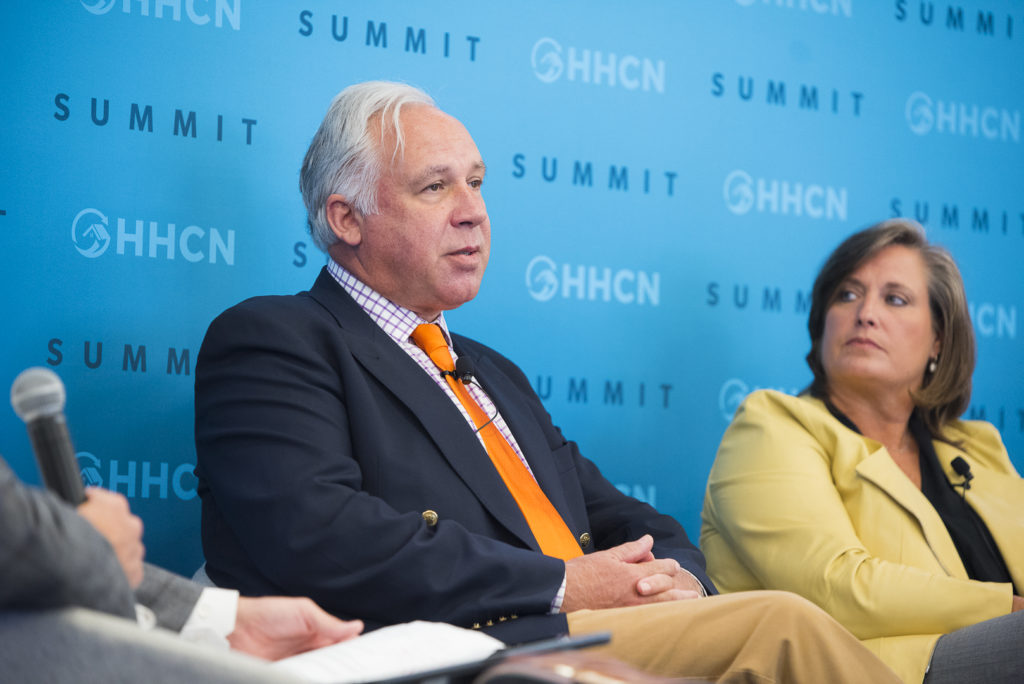With interest in scaled home health assets climbing among strategic buyers, few, if any, large home health companies are likely to stay independent, according to Amedisys (Nasdaq: AMED) CEO Paul Kusserow.
Kusserow made these remarks at a dinner hosted by Jefferies Financial Group, according to Brian Tanquilut, equity analyst for the investment banking firm.
“As [Amedisys management] discussed the home health landscape beyond [near-term] labor and payor mix challenges, they noted their view that there’s scarcity in quality home health capacity and high level of interest among potential strategic acquirers to own scaled home nursing companies …,” Tanquilut indicated in a note. “Managed-care companies are showing increasing interest in partnering with or potentially owning home nursing operators in order to reduce the cost of care for patients with chronic conditions.”
Recent home health transactions lend credence to these observations — Humana, Inc.’s $5.7 billion acquisition of a 100% stake in Kindred at Home and Optum Health’s pending purchase of LHC Group (NASDAQ: LHCG) for $5.5 billion. Optum is a subsidiary of UnitedHealth Group (NYSE: UHN).
Deals like these allow payers to capitalize on growing demand for home-based care and move more patients into a lower cost setting. They also present an opportunity to better manage the financial risk associated with value-based reimbursement systems.
“I’d really think about the way we’ve built the home capabilities as a substantial extension of what we’re able to do in the clinical space … That’s a super important part of the environment,” UnitedHealth Group CEO Andrew Witty said in a recent earnings call. “That is resonating super strongly, not just with UnitedHealth Care, but with other payers as well. And there’s no doubt that this side of the agenda has caught the imagination of other payers.”
But currently, both payers and providers need to wrestle their way out of the bear trap set by the labor shortage, the main culprit behind the capacity constraints that Tanquilut referenced in the note.
This industry-wide headwind has been the primary contributor to Amedisys’ uneven earnings performance last year, particularly during the summer months. These shortfalls precipitated Kusserow’s return as the company’s chief executive following the departure of former CEO Chris Gerard early in Q4.
Amedisys’ net service revenue rose to $558 million in Q3 2022, up from $533.5 million in the prior year’s quarter. The increase fell short of Wall Street expectations and led the company to reduce its guidance for 2022. Moreover, adjusted earnings per share (EPS) hit $1.15 in Q3, down 24.8% year-over-year.
“We haven’t hit and been predictable on the earnings,” Kusserow said at the Bank of America Securities Home Care Conference in December. “So that’s the reason I’m back.”
Re-establishing that consistency is largely contingent on the labor front, a top priority for Kusserow.
Thus far, while no one is out of the woods when it comes to workforce pressures, Amedisys may be on the right path. The company has brought its nurse turnover rates down to 20%, better than the industry average, and they see opportunities ahead that could make a further dent, according to Tanquilut’s note.
“Incremental turnover reduction will be driven by macro factors (counter-cyclical nature of nurse staffing), modest rate growth (+3% raise given in late 2022), and initiatives (lifestyle- & productivity-focused operational tweaks) aimed at enhancing the attractiveness of working for AMED,” Tanquilut indicated. “With broader demand for home nursing remaining robust, gains in clinician capacity should translate to incremental growth.”
Companies featured in this article:
Amedisys Inc., Humana Inc., Jeffries LLC, Optum, UnitedHealth Group




